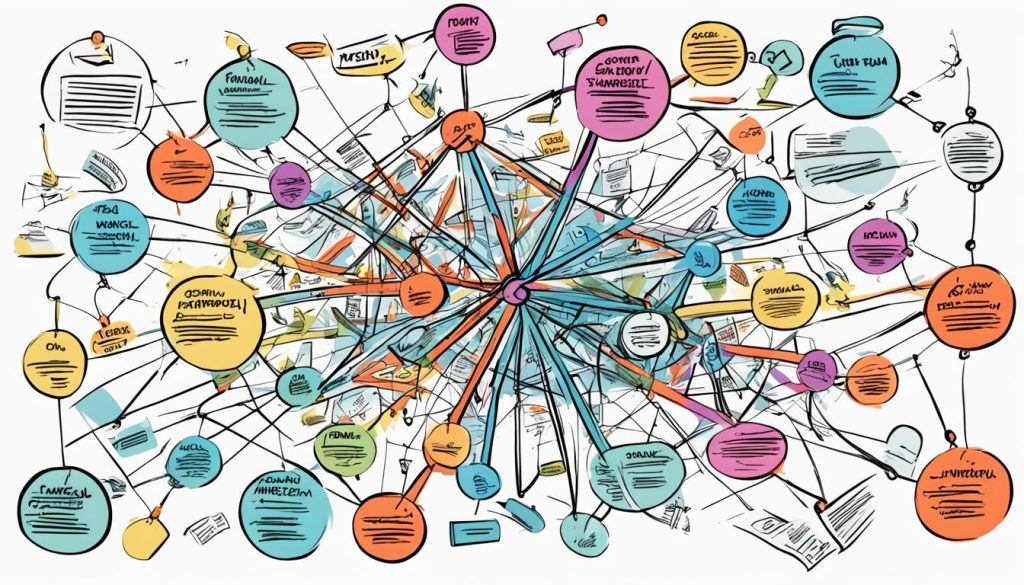As a business owner or investor, you know how vital financial statements are. They’re like the “language of finance.” They show the real health and potential of any company. But, they also hide risks and chances that could change your financial future.
We’re going to explore financial statements together. We’ll look at the balance sheet, income statement, and cash flow statement. These documents paint a full picture of a company’s finances.
If you’re an entrepreneur, an investor, or a seasoned executive, this guide will help you. It will give you the tools and insights to understand financial statements well1. With over 155,000 angels and 50,000 VCs ready to invest, knowing financial statements is key to getting the right investors and funding1.
Let’s dive into financial statements. We’ll find the hidden risks and chances they hold. We’ll cover accrual accounting, GAAP, and IFRS, and how to spot financial tricks1. It’s important to know how to see through false promises of big tax savings and high returns1.
Key Takeaways
- Financial statements are key to a business’s health and help with making smart decisions.
- Understanding financial statements can reveal hidden risks that could affect your strategy.
- Knowing the balance sheet, income statement, and cash flow statement is crucial for managing finances well.
- Learning about accounting principles like GAAP and IFRS helps you understand financial statements better.
- Being able to spot financial deception and red flags is important in finance.
- https://criminalinjurylaw.com/insurance-fraud-cases-the-thin-line-criminals-walk-in-injury-cases-4/
Investor’s Lens: Unveiling Opportunities and Risks
As an investor, your main goal is to find companies that could grow a lot while avoiding risks. You’ll look at financial metrics and ratios to see how well a company does in making money, managing cash, and staying financially stable2. These indicators can show you where there might be good chances and where there could be problems, helping you make smart choices.
Profitability Ratios
Profitability ratios like gross profit margin, operating profit margin, and net profit margin tell you how well a company controls costs and makes money2. A high gross profit margin means the company can set its prices well and keep costs low. But a falling operating profit margin might mean it’s struggling with expenses.
Liquidity Ratios
Liquidity ratios, like the current ratio and quick ratio, show if a company can pay its short-term bills2. A strong current ratio means it has enough current assets to cover current liabilities. A high quick ratio shows it can quickly pay off short-term debts.
Solvency Ratios
Solvency ratios, such as the debt-to-equity ratio and interest coverage ratio, tell you about a company’s long-term financial health2. A low debt-to-equity ratio shows smart use of debt. A high interest coverage ratio means the company can pay its debts from earnings.
Earnings Per Share (EPS)
Earnings per share (EPS) shows how profitable a company is for each share2. This helps you see if the company can give good returns to its shareholders and guide your investment choices.
Looking at these financial ratios and metrics gives you a full picture of a company’s financial health, growth chances, and risks3. It’s key to look at both numbers and other factors to make smart investment decisions.
“Investing is not just about chasing the latest trends or hot stock tips. It’s about understanding the underlying fundamentals that drive a company’s long-term success.”
Analyst’s Perspective: Digging Deeper
Financial analysts have a special view when looking at a company’s finances. We use advanced methods to find hidden stories and risks. These methods help us spot things that regular investors might miss4.
Horizontal Analysis
Horizontal analysis lets us compare a company’s finances over time. This helps us see trends, odd points, and areas to watch4. By looking at year-over-year and quarter-over-quarter changes, we can see what’s driving a company’s success. This could be changes in costs, profit margins, or how well they use their assets5.
Vertical Analysis
Vertical analysis shows each financial item as a percentage of total revenue or assets4. This makes it easier to compare companies. It shows us how a company’s costs and financial setup stack up against others5.
Common-Size Statements
Common-size statements turn all financial data into percentages4. This helps us deeply understand a company’s costs, profits, and overall performance. It lets us see where a company can improve or change its strategy.
DuPont Analysis
DuPont analysis breaks down return on equity (ROE) into three main parts: profit margin, asset turnover, and financial leverage5. By looking at these, we can see what’s working well and what’s not in a company’s financial plan. This helps us suggest ways to increase value for shareholders.

Being an analyst is more than just numbers. It’s about finding the stories in financial statements4. By using these detailed methods and understanding the industry, we give investors and business owners the insights they need. This helps them make smart choices6.
Business Owner’s Insights: Strategic Decision-Making
As a business owner, you know how vital financial statement analysis is for making smart decisions. It’s key to your company’s long-term success7. Using tools like net present value (NPV) and internal rate of return (IRR) helps you pick the best investments7. Also, looking at historical data and trends is crucial for planning7.
Ratio analysis is also important. It lets you see how your company stacks up against others in the industry8. This way, you can spot areas where you can do better8.
Understanding the link between cash flow and profits is key to making smart financial choices7. By keeping an eye on your cash flow, you can make timely decisions to boost your business’s efficiency and profits7. Forecasting cash flow helps you plan for the future and make informed decisions7.
Your balance sheet gives a clear picture of your business’s value7. It shows what you own, what you owe, and what you’re worth7. This info helps you manage risks, decide on dividends, and plan for buying or selling assets7. Looking at your income statement can also guide you by showing where you can improve7.
Using data from your financial statements helps you make strategic decisions confidently7
“Financial statements are the language of business, and mastering their interpretation is crucial for strategic decision-making.” – Warren Buffett
The Underwriting Chronicles: Unmasking the Quirky Secrets of Credit Risk
The underwriting process is a fascinating journey into the world of credit risk. Underwriters act like financial detectives, looking closely at a borrower’s financial past to find risks9. They check many things, like income and credit scores, to guess if someone might not pay back the loan. This might seem odd, but it’s key for lenders to make smart choices and avoid loan defaults.
The Bizarre World of Underwriting
Underwriting is a special field that needs a wide range of skills. People in this job must be good at reading complex financial reports, using algorithms to predict the future, and paying attention to details9. At top companies like Canada ICI, underwriters deal with many transactions yearly, learning from their work and sharing tips with each other9.
The Sherlock Holmes of Credit Risk
Underwriters are like financial detectives, finding hidden clues and putting them together to assess risk. They look closely at a borrower’s financial past, checking income and spending. This careful look helps them spot warning signs and decide if someone can handle a loan.
The Crystal Ball of Predictions
The underwriting process looks at the past and predicts the future. Underwriters use advanced tools and data to guess if a borrower can pay back the loan10. This helps lenders avoid defaults and keep their loans safe over time.
The underwriting process might seem strange, but it’s crucial for managing credit risk. By looking at financial histories and using predictions, underwriters help protect both lenders and borrowers.
“Successful underwriters are well-rounded, appealing candidates for higher positions or lateral moves within a company9. The President of Canada ICI, Rick Bachalo, has a background in underwriting, showing how important this role is in the industry.”9
The underwriting process is complex but key to finance. By understanding its quirks, borrowers and lenders can move through the credit risk world with more confidence and safety910.
Unmasking Hidden Financial Risks with Moody’s Shell Company Indicator
Shell companies are often used for illegal activities like money laundering and fraud11. Moody’s has created a tool to fight this – the Shell Company Indicator. It uses data to find suspicious patterns, showing the dangers of these hidden companies11.
The Moody’s Shell Company Indicator looks at over 460 million companies in the Orbis database to find potential shell companies11. It checks for signs like many registrations at once, circular ownership, and financial oddities. This helps spot risky companies quickly11.
As of November 2023, the tool has flagged over 21 million risk activities across 472 million companies12. It can spot both simple and complex risks, giving a full view of the dangers in a company or network12.
Using Moody’s Shell Company Indicator helps companies stay ahead of threats from shell companies11. It updates regularly and is easy to use, helping businesses make smart choices and protect themselves from financial crimes11.

Adding Moody’s Shell Company Indicator to compliance efforts is a big step against financial crimes11. It uses data and analytics to reveal hidden risks. This helps companies make better decisions and strengthens the global financial system11.
financial statements: Decoding the Language of Financial Health
Financial statements show a company’s financial health. They give a full view of its performance, how liquid it is, and if it can pay its debts13. It’s key to know about accrual accounting and GAAP or IFRS to understand these statements well14.
The main financial statements are the income statement, balance sheet, and cash flow statement. The income statement shows a company’s earnings, costs, and profits over time15. The balance sheet lists its assets, debts, and equity at one point, showing its financial state15. The cash flow statement looks at cash coming in and going out, helping to see if a company can manage its money well15.
Looking at these statements gives important info for investors, lenders, and company leaders15. Investors use this info to decide if they should buy, hold, or sell stocks based on how profitable and stable a company is15. Lenders check if a company can pay back its debts by looking at its cash flow and debt levels. Company leaders use these statements to make decisions, plan resources, and set strategies15.
Understanding financial statements helps you see a company’s financial health better. Knowing how to navigate legal issues is also key when facing criminal charges. It helps protect your rights and interests13.
Fundamental Financial Statements
The main financial statements – the income statement, balance sheet, and cash flow statement – give different insights into a company’s finances:
- The income statement shows a company’s income, costs, and profit or loss over time15.
- The balance sheet gives a snapshot of a company’s finances at a certain point, showing its assets, debts, and equity15.
- The cash flow statement looks at cash movements, grouping them into operating, investing, and financing activities15.
By looking at these statements, you can understand a company’s financial health better and make smarter choices15.
“Financial statements are the language of a company’s financial health, providing a comprehensive view of its performance, liquidity, and solvency.”
Getting good at understanding financial statements is a skill that helps investors, lenders, and business owners13. It’s useful whether you’re dealing with legal issues or financial matters. Knowing the basics and insights can lead to better decisions and protect your interests131514.
Conclusion
Mastering financial statements analysis is key for smart finance decisions. By diving into the details of financial statements, you can spot risks and find chances for your financial strategy. For investors, business owners, or financial, understanding financial statements helps you make confident choices16.
Financial statements act as a guide to a company’s financial health. By studying them, you move closer to your financial goals. You’ll grasp the balance sheet, income statement, cash flow statement, and equity statement. This lets you check a company’s profitability, liquidity, and solvency. You can also look at earnings per share (EPS) and other important numbers16.
Getting good at financial statement analysis helps you make smarter investment decisions. It also helps in managing risk and planning for the future. Use the power of financial statements to find hidden insights. This will lead you to more financial success171816.,,
FAQ
What are the primary financial statements and what do they reveal?
The main financial statements are the income statement, balance sheet, and cash flow statement. They show a company’s earnings, spending, and cash flow. The income statement shows income and expenses. The balance sheet lists assets, liabilities, and equity. The cash flow statement shows cash coming in and going out.
What are the key financial ratios that investors use to assess a company’s performance?
Investors look at financial ratios to check a company’s profits, cash flow, and debt. Ratios like gross profit margin and net profit margin show how well a company makes money. The current ratio and quick ratio check if a company can pay its short-term debts. Debt-to-equity and interest coverage ratios show if a company can handle its debts over time. Earnings per share (EPS) shows profits per share.
What are the common analytical techniques used by financial analysts to gain deeper insights?
Financial analysts use techniques like horizontal and vertical analysis to understand a company better. Horizontal analysis looks at financial data over time to spot trends. Vertical analysis shows each item as a percentage of total revenue or assets for easy comparison.
Common-size statements turn financial statements into percentages for easier analysis. DuPont analysis breaks down return on equity into profit margin, asset turnover, and financial leverage.
How can business owners use financial statement analysis to make strategic decisions?
Business owners should analyze financial statements to make smart decisions. They need to manage working capital well and evaluate investments using methods like net present value (NPV) and internal rate of return (IRR). Forecasting based on past data and trends is also key.
Ratio analysis helps owners see how their company stacks up against others in the industry. This helps spot areas to improve.
What is the role of underwriters in the credit risk assessment process?
Underwriters are key in assessing credit risk. They look into a borrower’s financial history to find potential risks. They check income, expenses, and credit to predict default likelihood. Underwriters use skills to understand complex financial statements and predict future outcomes.
How can Moody’s Shell Company Indicator help uncover hidden financial risks?
Moody’s Shell Company Indicator helps find risks from shell companies. These companies can hide illegal activities and money. The indicator uses data to spot suspicious corporate behavior, like circular ownership and financial oddities. This helps companies catch and prevent risks from shell companies.
What is the importance of understanding the principles of financial reporting, such as accrual accounting and GAAP/IFRS?
Knowing financial reporting basics like accrual accounting and GAAP/IFRS is key. These rules tell us how to record and report financial transactions. They make sure companies are consistent and comparable across the board.

